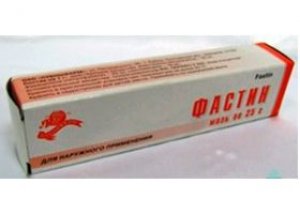
All iLive content is medically reviewed or fact checked to ensure as much factual accuracy as possible.
We have strict sourcing guidelines and only link to reputable media sites, academic research institutions and, whenever possible, medically peer reviewed studies. Note that the numbers in parentheses ([1], [2], etc.) are clickable links to these studies.
If you feel that any of our content is inaccurate, out-of-date, or otherwise questionable, please select it and press Ctrl + Enter.
Fastin
Medical expert of the article
Last reviewed: 03.07.2025

An ointment, the three components of which – benzocaine, nitrofural and synthomycin – provide bacteriostatic activity and a superficial anesthetic effect.
ATC classification
Active ingredients
Pharmacological group
Pharmachologic effect
Indications Fastina
It is used for external treatment of first- and third-degree skin burns, fresh and complicated by purulent-inflammatory processes, infected wounds and eczema accompanied by purulent exudation.
Release form
Tubes with ointment, dosed at 25g, packed in cardboard boxes with instructions for use inserted inside.
Pharmacodynamics
The ability to stop the growth and development of pathogenic microbial flora is due to the presence of the antibiotic chloramphenicol (syntomycin) and the antiseptic nitrofural (furacilin) in the ointment.
After binding to the RNA of the pathogen cell, the active component of the antibiotic inhibits the enzymatic activity of peptidyl transferase, which interrupts the process of synthesizing protein molecules in the cell of the sensitive pathogen. Syntomycin is active against most gram-positive and gram-negative cocci, Escherichia coli and Haemophilus influenzae, Salmonella, Shigella and spirochetes, anaerobes, etc.
The antiseptic nitrofural synergistically increases the activity of the previous component to most pyogenic bacteria, in addition, some types of fungi are sensitized to it. The pathogenesis of nitrofural is quite specific: when the 5-nitro group is restored by protein enzymes of the pathogenic microorganism (flavoproteins), amines are formed that have a high reactive ability to bind to macromolecules, including RNA of the microbe, which ultimately leads to anomalies in the protein molecules of the pathogen's cells and its death.
In addition, nitrofural stimulates the activity of the body's macrophage system.
Microbial resistance to the above substances develops very slowly.
Benzocaine provides a superficial anesthetic effect of the ointment, preventing the appearance and conduction of nerve impulses by increasing the strength of the cell membrane, thus blocking the penetration of positive sodium ions. It also displaces positive calcium ions from the endings located on the inner surface of the cell membrane. When applied to a wound, the effect begins after a minute and lasts for about a third of an hour.
Dosing and administration
This product is applied to the affected skin surface. To do this, squeeze the required amount of ointment from the tube onto a piece of sterile bandage or gauze, spreading it in a thin layer. Then apply a bandage to the affected area. Bandages are recommended to be changed no more than once a week and no less than once every ten days. If necessary (pain, rapid accumulation of exudate in the inflammation site, etc.), the bandage is changed more often.
At the age of 0-5 years, the ointment is used only as prescribed by a doctor.
Use Fastina during pregnancy
There is no experience of use by pregnant and lactating women, so it is not recommended to use the ointment during this period.
Contraindications
The patient has psoriatic and/or eczematous rashes, dermatomycosis, skin manifestations of allergy; history of sensitization to the components of the ointment. Neonatal period.
Side effects Fastina
There is a possibility of developing hypersensitivity reactions, such as urticaria, including giant urticaria (Quincke's edema), skin itching, inflammation and irritation of the skin at the site of application.
Overdose
Exceeding the recommended dose may result in increased side effects.
Interactions with other drugs
There is no information on the interaction of the ointment components used externally with other medicinal substances.
Storage conditions
Store at temperatures below 30℃. Keep out of reach of children.
 [ 7 ]
[ 7 ]
Shelf life
2 years. Use no later than the date indicated on the package.
Manufacturer
Attention!
To simplify the perception of information, this instruction for use of the drug "Fastin" translated and presented in a special form on the basis of the official instructions for medical use of the drug. Before use read the annotation that came directly to medicines.
Description provided for informational purposes and is not a guide to self-healing. The need for this drug, the purpose of the treatment regimen, methods and dose of the drug is determined solely by the attending physician. Self-medication is dangerous for your health.

